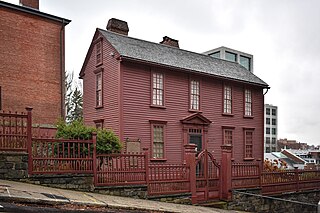
The Governor Stephen Hopkins House is a museum and National Historic Landmark at 15 Hopkins Street in Providence, Rhode Island. The house was the home of Stephen Hopkins—a governor of Rhode Island and signatory of the Declaration of Independence—as well at least six of his slaves.

The Nightingale–Brown House is a historic house at 357 Benefit Street on College Hill in Providence, Rhode Island. It is home to the John Nicholas Brown Center for Public Humanities and Cultural Heritage at Brown University. The house is architecturally significant as one of the largest surviving wood-frame houses of the 18th century, and is historically significant as the longtime seat of the Brown family, whose members have been leaders of the Providence civic, social, and business community since the 17th century, and include nationally significant leaders of America's industrialization in the 19th century. The house was listed on the National Register of Historic Places and declared a National Historic Landmark in 1989.

The William Mowry House is an historic farm house on Farnum Pike in North Smithfield, Rhode Island. It is a 2-1/2 story plank-framed house, five bays wide, with a gable roof and a large central chimney. The main entrance is centered on the main (south-facing) entry, and is enclosed within a single-story hip-roof vestibule of 20th-century construction. A small single-story ell extends to the west of the main block. The interior follows a typical center-chimney plan, with the kitchen and parlor in the front of the house, and the dining room flanked by a small pantry and bathroom in the rear. The house was built c. 1802-05 by William Mowry, whose family has owned land in the area since the 17th century.

The Israel Arnold House is an historic house on Great Road in Lincoln, Rhode Island. It is a 2+1⁄2-story wood-frame structure, set on a hillside lot on the south side of Great Road. The main block is five bays wide, with a central chimney rising through the gable roof. A 1+1⁄2-story gambrel-roofed ell extends to one side. The ell is the oldest portion of the house, built c. 1720 by someone named Olney. The main block was built c. 1760. The house was owned into the 20th century by four generations of individuals named Israel Arnold.

The John Arnold House is an historic house on 99 Providence Street in Woonsocket, Rhode Island. The main block of this two-story wood-frame house is conventionally believed to have been built in 1712, but there is architectural evidence parts of it may be even older. There are two additions: a two-story gable-roof section extending south, to which a mid-20th-century addition has been made. Elements of the house's antiquity remain in the main block despite its conversion to multiunit housing. The house is presumed to have been built by John Arnold, grandson of early Rhode Island settler William Arnold.

The Battey–Barden House is an historic house in Scituate, Rhode Island, US. It is a 2+1⁄2-story wood-frame structure with a large central chimney. A 1+1⁄2-story kitchen ell extends from the rear of the main block. The main block's construction date is uncertain, with architectural evidence suggesting it was built between about 1816 and 1831. It was probably built around 1824 for Horace Battey, a farmer and shopkeeper. The house is particularly notable for the stencilwork on its interior walls.

The Captain George Dorrance House is an historic house in Foster, Rhode Island. It is located on the west side of the road, a short way south of its junctions with Plain Woods Road, not far from the Connecticut border. It is a 2+1⁄2-story wood-frame structure, five bays wide, with a gable roof and a large central chimney. The main block was built c. 1720, and a leanto was added c. 1750. It is one of the best-preserved early 18th-century houses in the state.

The Jenckes House is a historic house at 1730 Old Louisquisset Pike in Lincoln, Rhode Island, United States. It is a 2+1⁄2-story timber-frame structure, five bays wide, with a large central chimney. The main entrance is flanked by pilasters and topped by a transom window and heavy molded cap. Additions extend the house to the south and northwest. The main block is estimated to have been built around 1760, by a member of the locally prominent Jenckes family.
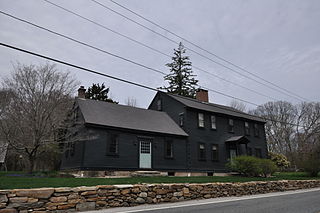
The Mount Vernon Tavern, also known as the Bank House Tavern, is an historic house in Foster, Rhode Island. It is located at 199 Plainfield Pike, about 3/10 of a mile east of its junction with Howard Hill Road. The main block of the house, a 2+1⁄2-story wood-frame structure with gable roof, was built c. 1760, and was originally attached to an even older structure which was demolished in the late 19th century. This main block, five bays wide with a central chimney, is attached to a 1+1⁄2-story gable-roofed ell to the west. The main entrance portico features unusually elaborate Federal styling for a rural location, and was probably added in 1814. The house has long been a landmark on the road, serving as a stagecoach stop on what was the main road between Providence and points in Connecticut.

The Allen–Madison House is a historic house on Marine Road in North Kingstown, Rhode Island. It is located on the grounds of the former Davisville Naval Construction Battalion Center, set on an isolated plot apart from the main portion of the base.

The Babcock House is a historic house also known as Whistling Chimneys, located on Main Street in the Quonochontaug section of Charlestown, Rhode Island.

The R.R. Gardner House is a historic house located in South Kingstown, Rhode Island.

The Joseph Jeffrey House is an historic house on Old Mill Road in Charlestown, Rhode Island. It is located on the east side of Old Mill Road, just south of Saw Mill Pond and Sawmill Brook, on a predominantly wooded 9.5-acre (3.8 ha) lot. The main house is a 1+1⁄2-story wood-frame structure with a gambrel roof and central chimney, with a small gable-roof ell to the northeast. The oldest portion of the main block appears to be the easterly side, which rests on an old stone foundation, and exhibits construction methods typical of the second quarter of the 18th century. The house was probably built by Joseph Jeffrey, a Narragansett, on land granted to him by the tribe, whose advisory council he sat on.
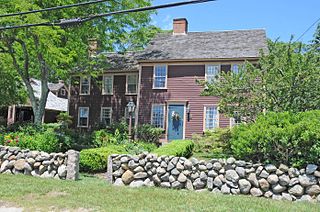
The Red House is a historic house in South Kingstown, Rhode Island. The main block, a 2+1⁄2-story wood-frame structure was probably built sometime in the early 18th century, and has long been a landmark in the Perryville village, receiving its name in the early 19th century. It is distinctive for period houses because of its asymmetrical facade, and was carefully restored in the late 1980s.
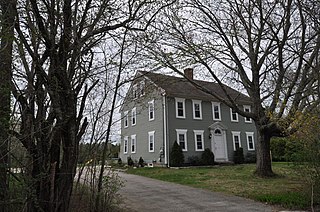
The Joseph Briggs House, also known as the Coventry Town Farm, is a historic house in Coventry, Rhode Island. The main block of the house, a 2+1⁄2-story wood-frame structure, was built c. 1790 by Joseph Briggs, and the property was purchased from his heirs in 1851 by the town for use as a poor farm. The town added a two-story ell to the rear of the house to provide additional housing space. The property is one of the few such poor farms to remain relatively intact. The farm was closed in the 1930s, after which the property fell into decline. It has since been rehabilitated as a two-family residence.
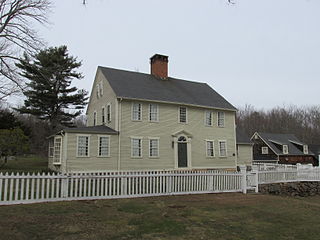
The Wilson–Winslow House is a historic house in Coventry, Rhode Island. The main block of this 2+1⁄2-story wood-frame house was built c. 1812, either by Joseph Wilson or his son Israel. The house is a high-quality example of vernacular rural Federal architecture, which was altered in the 1930s as a country retreat for the Winslows, a Providence family.

The General James Mitchell Varnum House is an historic house at 57 Peirce Street in East Greenwich, Rhode Island. The 2+1⁄2-story wood-frame house was built in 1773 for James Mitchell Varnum, who later served as a general in the Continental Army during the American Revolutionary War. It is five bays wide, with two interior brick chimneys. Its main entry is sheltered by a portico supported by fluted Ionic columns and pilasters. A 19th-century addition extends from the rear of the main block. Notable later residents of the house include George A. Brayton, who served as Chief Justice of the Rhode Island Supreme Court. The house was purchased in 1939 by the Varnum Continentals, and has since served as a museum.

The Allen–West House is an historic house at 153 George Street in Barrington, Rhode Island. The main block of the two story timber frame house was built c. 1763 by Joseph Allen, a housewright. It is one of the older houses in Barrington, hearkening to the days when it was still part of Swansea, Massachusetts, and is a well-preserved rare example of a vernacular square house plan. The house stands amid grounds that were farmed from the 17th to the 20th centuries by the owners of this house, who included members of the Allen family until the mid-19th century, and the Wests until the mid-20th. The house has had two major additions: a kitchen ell added to the east in the 19th century and extended in the 1950s, and a c. 1920s single-story enclosed porch on the west side.

The William B. Spencer House is a historic house at 11 Fairview Avenue in the Phenix village of West Warwick, Rhode Island. The 2+1⁄2-story wood-frame house was built in 1869–70, and is an elaborate and well-preserved instance of Late Victorian Italianate style. The house has an L shape, with forward projecting gable section on the left, in front of a rectangular main block. A single-story porch with slender columns and decorative woodwork valances extends across the front to the right of the projecting section. The windows on the projecting section are three-part rounded windows, each with distinctive and elaborate hoods. The building corners are quoined, and the roofline features dentil moulding and paired brackets. A series of smaller ells project to the right of the main block, and there is a small single-story addition to the rear. The main block is topped by an octagonal cupola with round-arch windows. The building's owner, William B. Spencer, was a local entrepreneur who made his fortune by dealing in the waste materials generated by the local cotton mills.

The Esten–Bowen House is a historic house at 299 Ironmine Road in Burrillville, Rhode Island. The 1 1/2 story timber frame Cape style house was built c. 1790 by John Esten, a major landowner in eastern Burrillville in the second half of the 18th century. The main block is five bays wide and two deep, with a massive central chimney. A kitchen ell to the right of the main block appears to be an early addition. The house was held in the Esten family until 1879, by which time its surrounding property had been reduced to just 30 acres (12 ha). This property was acquired by Esther Bowen in 1941 and the house was rehabilitated, with modest Colonial Revival alterations. The property includes a 19th-century shed, and foundational remnants of a blacksmithy and barn.






















